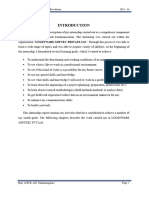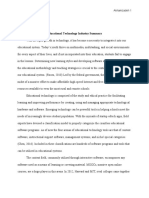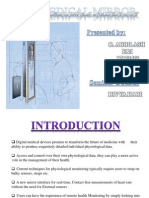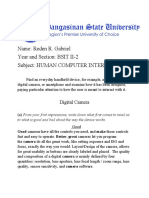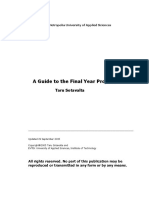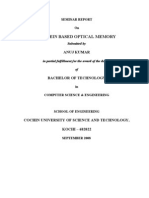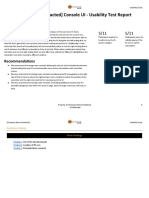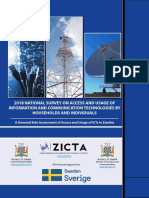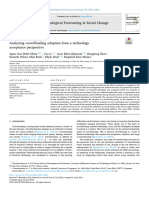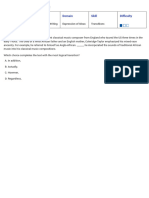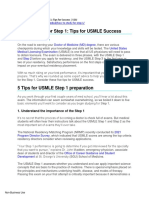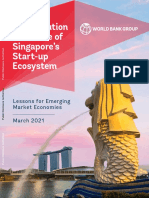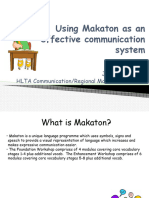Survey on the Intention to Use Tablet PCs Among Students:
An IDT Perspective
A tablet personal computer (PC) is a complete mobile computer, larger than a mobile phone or personal digital
assistant, which is integrated into a flat touch screen and operates primarily by touching the screen. Rather than
a physical keyboard, it often uses an onscreen virtual keyboard, a passive stylus pen, or a digital pen. Recently,
the tablet PC market was reinvigorated by Apple through the introduction of the iPad device in 2010. Following
iPads huge success, many other tablets by competing companies such as the Samsung Galaxy Tab rapidly
emerged. Considering the rising popularity of tablet PCs, this survey intends to investigate university students
intention to use such devices.
Instructions: Please read each question carefully and respond to all questions to the best of
your ability by placing a check () for each question.
3- Neutral
(N)
5- Strongly
Agree (SA)
2- Disagree
(D)
4-Agree (A)
1-Strongly
Disagree
RA1
Using a tablet PC will improve the quality of my studies.
RA2
Using a tablet PC will make it easier to do my studies.
RA3
Using a tablet PC will enhance my effectiveness in my
studies.
RA4
Overall, I would find using a tablet PC to be advantageous
in my studies.
COM1
Using a tablet PC will fit into my study style.
COM2
Using a tablet PC will be compatible with all aspects of
my studies.
COM3
I think that using a tablet PC will fit well with the way I
like to study.
IMG1
People who use a tablet PC have more prestige than those
who do not.
IMG2
People who use a tablet PC have a high profile.
IMG3
Having a tablet PC is a status symbol.
EOU1
Learning to operate a tablet PC will be easy for me.
Item
code
Description of items
�3- Neutral
(N)
5- Strongly
Agree (SA)
2- Disagree
(D)
4-Agree (A)
1-Strongly
Disagree
EOU2
Using a tablet PC will require a lot of mental effort.
EOU3
I believe that it will be easy to get a tablet PC to do what I
want it to do.
EOU4
Overall, I believe that a tablet PC will be easy to use.
RDM1
I would have no difficulty telling others about the results
of using a tablet PC.
RDM2
I believe I could communicate to others the pros and cons
of using a tablet PC.
RDM3
The results of using a tablet PC are clear to me.
RDM4
I would not have difficulty explaining why using a tablet
PC may or may not be beneficial.
VIS1
I have seen what others do using their tablet PCs.
VIS2
It is easy for me to observe others using tablet PCs.
VIS3
I can see many individuals having or using tablet PCs.
TRI1
I want to be able to use a table PC on a trial basis long
enough to see what it can do.
TRI2
I want to have a great deal of opportunity to try out
various tablet PC applications.
TRI3
I would be able to satisfactorily try out various uses of
tablet PCs.
TRI4
Before deciding whether to use any tablet PCs
applications, I would want to be able to properly try them
out.
INV1
Other people come to me for advice on new technologies.
INV2
I am among the first in my circle of friends to acquire new
technology when it appears in the market.
INV3
I can usually figure out new high-tech products and
services without help from others.
INV4
I keep up with the latest technological developments in my
area of interest.
Item
code
Description of items
�3- Neutral
(N)
5- Strongly
Agree (SA)
2- Disagree
(D)
4-Agree (A)
1-Strongly
Disagree
INV5
I enjoy the challenge of figuring out high-tech gadgets.
INV6
I find that I have fewer problems than my
coursemates/friends do in making technology work for
me.
ATT1
Using the tablet PC would be a good idea.
ATT2
Using the tablet PC would be pleasant experience.
ATT3
Using the tablet PC would be beneficial for me.
ATT4
I would like using the tablet PC.
INT1
Assuming I have the tablet PC, I intend to use it.
INT2
Whenever possible, I intend to use the tablet PC.
INT3
To the extent possible, I would use the tablet PC to do
different things.
INT4
I intend to increase my use of the tablet PC in the future.
Item
code
Description of items
PERSONAL PROFILE
1. What is your age? _______ years old
2. What is your gender? ____1.Male
____2. Female
3. What is your race/ethnicity?
____1.
____2.
____3.
____4.
Malay
Chinese
Indian
Others _________________(please specify)
4. What is your nationality?
____1. Malaysian
____2. Others _________________ (please specify)
�5. What is your year of study?
____1.
____2.
____3.
____4.
First year
Second year
Third year
Fourth year and above
6. What programme are you registered for?
____1. Bachelors degree (undergraduate)
____2. Masters
____3. PhD
7. What is the status of your candidacy?
____1. Part time
____2. Full time
8. Which school/faculty are you from? ___________________________
9. Do you live in or outside campus?
____1. In campus
____2. Outside campus
10. What is your current CGPA level? ____________________________
INTERNET EXPERIENCE
11. How long (in years or months if less than 1 year) have you been using the internet?
_____________________
12. Do you have internet access at home?
____1. Yes ____2. No
13. Where do you primarily access internet from?
____1. Home
____2. Place of employment
____3. School/academic institution
____4. Cybercafe
____5. Others (please specify) _____________________
14. Which web browser do you usually use?
____1. Internet explorer
____2. Mozilla Firefox
____3. Others (please specify) _____________________
____4. More than one browser
�15. On an average day, how much time do you spend using the internet?
____1.
____2.
____3.
____4.
____5.
____6.
Almost never
Less than 0.5 hours
From 0.5 hours to 1 hour
1-2 hours
2-3 hours
More than 3 hours
16. On average, how often do you use internet?
____1.
____2.
____3.
____4.
____5.
____6.
Less than once a month
Once a month
A few times a month
A few times a week
About once a day
Several times a day
END OF SURVEY
THANK YOU VERY MUCH FOR YOUR KIND COOPERATION
�INTENTION TO USE TABLET PCs AMONG STUDENTS: AN IDT PERSPECTIVE
Research Framework
Relative Advantage
Compatibility
Image
Ease of Use
Intention to Use
Tablet PCs
Result
Demonstrability
Visibility
Trialability
Innovativeness
Theory: Innovation Diffusion Theory (Rogers, 1995; Moore & Benbasat, 1991)
Description of constructs used in the questionnaire
Item no.
RA1, RA2, RA3,
RA4
Variable name
Relative Advantage
Source
Moore & Benbasat (1991)
No. of Items
4
COM1, COM2,
COM3
Compatibility
Moore & Benbasat (1991)
IMG1, IMG2, IMG3
Image
Moore & Benbasat (1991)
�EOU1, EOU2,
EOU3, EOU4
Ease of Use
Moore & Benbasat (1991)
RDM1, RDM2,
RDM3, RDM4
Result Demonstrability
Moore & Benbasat (1991)
VIS1, VIS2, VIS3,
Visibility
Moore & Benbasat (1991)
TRI1, TRI2, TRI3,
TRI4
Trialability
Moore & Benbasat (1991)
INV1, INV2, INV3,
INV4, INV5, INV6
Innovativeness
Parasuraman (2000)
ATT1, ATT2, ATT3,
ATT4
Attitude towards Using
Tablet PCs
Park & Chen (2007)
INT1, INT2, INT3,
INT4
Intention to Use Tablet
PCs
Park & Chen (2007)
References
Moore, G.C. & Benbasat, I. (1991). Development of an instrument to measure the perceptions of
adopting an information technology innovation. Information Systems Research, Vol. 2, No. 3, pp. 192222.
Parasuraman, A. (2000). Technology Readiness Index (TRI). Journal of Service Research, Vol. 2, No.
4, pp. 307-320.
Park, Y. & Chen, J.V. (2007). Acceptance and adoption of the innovative use of smartphone. Industrial
Management & Data Systems, Vol. 107, No. 9, pp. 1349-1365.
Rogers, E. (1995). Diffusion of Innovations. New York: Free Press.


















